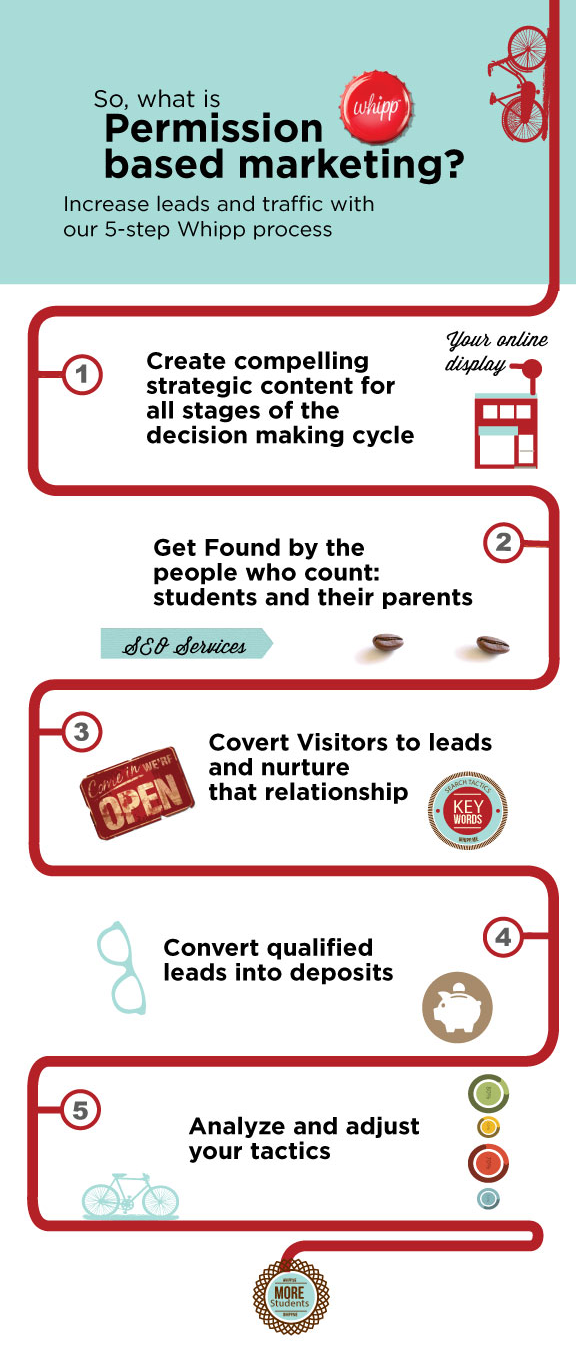
Traditional College Marketing strategies are outbound, which relies on blasting a message to thousands of random and possibly uninterested people through media placed on such vehicles as billboards, radio, and direct mail in hopes of getting a small return percentage of that audience responds to the message.
Whipp's new admissions marketing strategy, permission based marketing, solves this problem and saves money.
In our permission based model, strategic content is created to attract visitors to you. Once qualified visitors are on your website, a series of campaign components are employed to convert those visitors to leads and the leads to new students.
Step 1
Create compelling strategic content for all stages of the decision making cycle
Before potential students and parents can find you, you must first create valuable content that will attract them to your site. Once they come to the site, you must have a content strategy that charms them through a decision sales funnel.
99% of the traffic to your site is just looking, browsing, or window-shopping. Once they leave your website, most never come back. Your content strategy will determine whether they come back or not. It is that simple and that important.
Step 2
Get Found by the people who count-students and their parents
92% of students and parents find their college of choice by search. Why spend money to compete for that 8% with an outbound budget? 95% of college admission offices use at least one form of social media.
Get in the game for that 92%.
Part of our program uses advanced search marketing techniques like competitive benchmarking, link exchange, and optimizing keywords (targeted to students and parents) that will insure your content is found when they are actively engaged in the all important search process.
Step 3
Covert Visitors to leads and nurture that relationship
Calls to action (CTA) let your visitors know what you want them to do and directs them the appropriate landing pages you've created. CTA’s need to catch the attention of your potential students and ask a fun demand like “click here for this awesome college starter toolkit.”
A Landing page allows a website visitor to share their contact information and helps you identify the type of information they are interested in. They get their cool starter kit and you get their information like name, high school, and email.
As you build out a list of people interested in your content, you can measure what content they are interested in and what stage of decision they are in. You then can intelligently coax that prospect down the decision funnel with proper nurturing tools like email and social media.
Step 4
Convert qualified leads to deposits
With our process, your offers and landing pages are tailored to people at all stages of the decision process, which means you can spend your valuable sales time taking to those who are at the bottom of the decision funnel ready to fill out an application or put down a deposit. We simply automate the communication with those in the earlier stages of the decision cycle, so you can concentrate on the 20% that will come to your school without abandoning potential new students who aren’t quite ready to jump on board with you just yet.
Step 5
Analyze and adjust your tactics
The final step of our process is to monitor your results and make adjustments to your strategy. Are the leads getting "stuck" somewhere in the decision making funnel? Proper monitoring and analysis will help pinpoint the areas to adjust your offers and content.
Our permission based admissions marketing strategy is an ongoing process.
It requires constant care and updating. But when it is executed correctly and consistently, it creates an ongoing system that creates and builds search equity and will continuously generate qualified leads for your school. Any money spent in this program is an equity investment that never fades.

